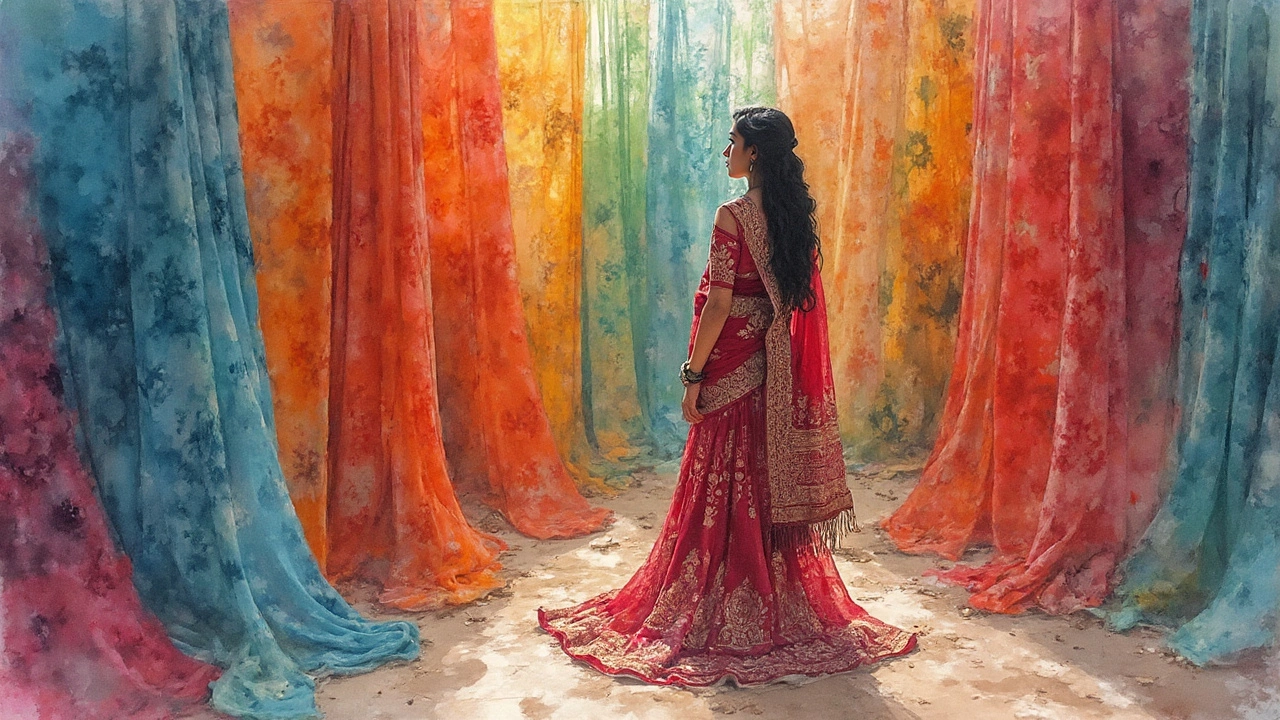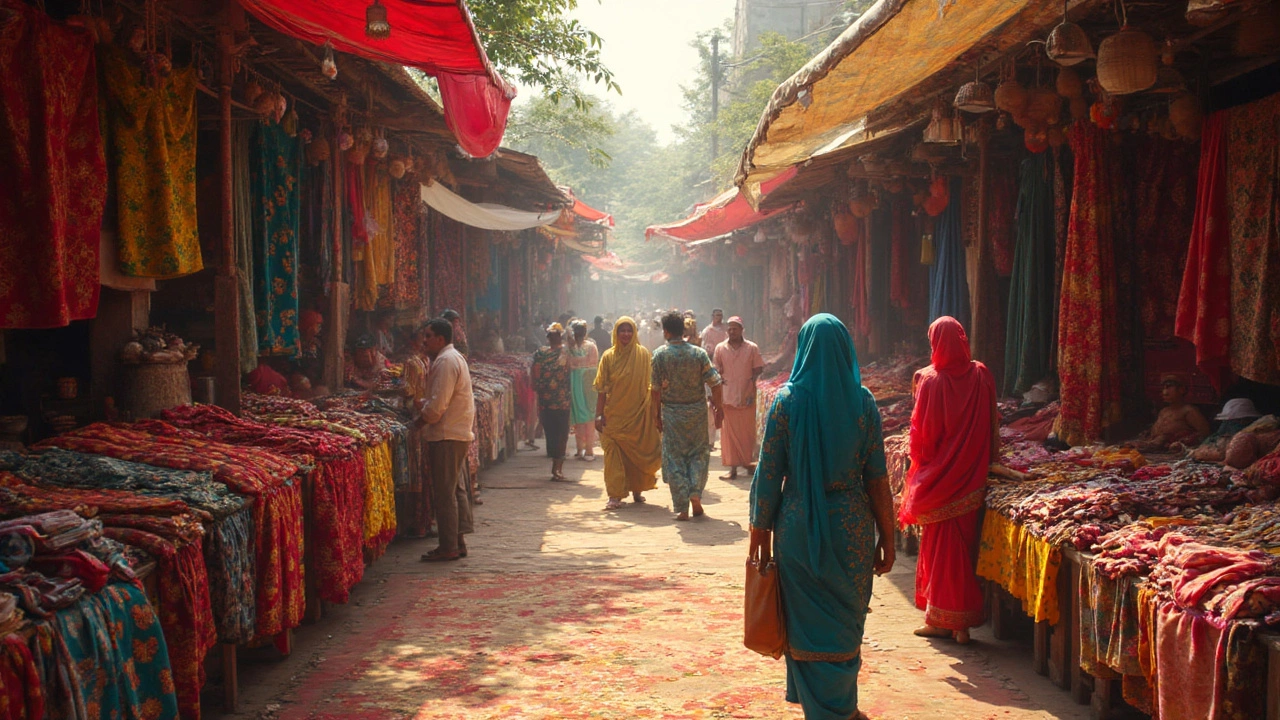Indian textiles have a way of catching the eye and telling a story with every thread. What makes them so distinctive? It's all about the aesthetic, a harmonious blend of culture, tradition, and artistry. This rich and colorful world of Indian fabric is renowned for its unique identity and craftsmanship.
Let's talk about color first. Indian fabrics are often bursting with vibrant hues, each shade carrying a significance. This isn't just about looking pretty; it's a language of its own. From the deep reds that symbolize passion to the calming blues representing depth, every color tells a part of the story.
- Understanding the Indian Aesthetic
- The Role of Color and Patterns
- Traditional Techniques and Modern Adaptations
- The Impact of Culture and History
- Global Influence and Market
Understanding the Indian Aesthetic
The heart of Indian aesthetic in textiles is a melting pot of historical influences, cultural traditions, and artistic expressions. This unique approach sprouted from centuries of diverse cultural exchanges, weaving together threads of Mughal, Persian, and indigenous styles. What you get is an enchanting tapestry that's distinctly Indian.
One striking feature of Indian textiles is their intricate patterns. These designs often reflect local traditions and stories, making each piece a visual feast. For instance, the paisley pattern, now popular worldwide, has its origins in Indian design. It’s a tiny detail but speaks volumes about the attention to craftsmanship.
The Indian aesthetic thrives on symbolism. Spanning religion, nature, and everyday life, symbols are deeply embedded in the fabrics. You might spot elephants, peacocks, or lotus motifs, each brimming with cultural significance.
Material Selection: A Key Factor
Materials play a critical role. Fabrics like cotton and silk aren’t just chosen for comfort but also for their symbolic and historical value. Cotton, for example, has been a staple since ancient times, celebrated for its simplicity and durability.
Silk, on the other hand, symbolizes luxury and opulence. Used in special garments and ceremonies, it’s often embroidered with gold and silver threads, showcasing the artistry behind these masterpieces.
The Cultural Canvas
The Indian textile scene is like a canvas where regions pour their signature styles. Think of the vibrant bandhni tie-and-dye from Gujarat or the ethereal chikankari embroidery from Lucknow. They're not just patterns; they're a reflection of the local culture and climate.
And guess what? The epicenter of this aesthetic wonderland isn't limited to the past. Modern designers continue to draw inspiration from traditional techniques, ensuring that the legacy and allure of Indian textiles remain evergreen.
The Role of Color and Patterns
Colors and patterns are at the heart of Indian aesthetic textiles. They bring textiles to life, transforming simple fabrics into pieces of art. This vibrant play of color and meticulous pattern work is what sets Indian fabric apart on the global stage.
Colors That Speak
Colors in Indian textiles aren't just chosen randomly. They're deeply rooted in history and culture. For example, saffron is a color of spirituality and bravery, while green is often linked to fertility and bliss. These colors are more than just visual appeal; they carry stories and meanings.
Interesting fact? The use of indigo, a deep blue dye, dates back to ancient India. It was so prized that it was referred to as 'blue gold.'
Patterns That Tell Stories
When it comes to patterns, Indian textiles boast some truly iconic designs. Designs like paisley, a curved teardrop shape, are a staple. Intricate floral motifs can transport you to lush Indian gardens, while geometric patterns can symbolize cosmic energy. Patterns are meticulously crafted, often inspired by nature, mythology, and everyday life.
Techniques and Tools
Creating these textiles isn't just about creativity; it involves skillful techniques. Block printing is particularly noteworthy, where wooden blocks dipped in dye create repetitive patterns. This ancient method is lovingly passed down through generations, emphasizing its importance in textile manufacturing.
The combination of vibrant colors and unique patterns is a cornerstone of Indian textile appeal, making it a must-see for anyone interested in the world of textiles.
| Color | Symbolism |
|---|---|
| Red | Passion and energy |
| Yellow | Joy and vitality |
| Blue | Depth and tranquility |
| White | Purity and peace |

Traditional Techniques and Modern Adaptations
India's textile industry is steeped in tradition, with techniques that have been honed over centuries. These age-old methods aren’t just about weaving fabric; they're about weaving stories and heritage into each piece.
Classic Techniques Still in Play
Techniques like block printing, which involve hand-stamping patterns onto fabric, are a staple of Indian textiles. This method, originating from the state of Rajasthan, uses intricately carved wooden blocks. It’s a meticulous process, but one that delivers rich, detailed designs. Another traditional art, bandhani or tie-and-dye, prevalent in Gujarat and Rajasthan, requires skill and precision to create its characteristic dotted patterns.
From Old to New: A Blend of Traditions
While these traditional techniques remain revered, modern adaptations have brought a fresher perspective. Contemporary designers are experimenting with fabrics like sustainable cottons and silk blends, merging old-world charm with new-age sensibilities. These modern takes on classic styles keep the textiles relevant, appealing to a global market while respecting their roots.
Modern Manufacturing Meets Artistry
The role of textile manufacturing in India has expanded beyond just crafting traditional attire. With technological advancements, manufacturers have found innovative ways to maintain the aesthetics while increasing efficiency. Machines replicate intricate designs once made by hand, like the Kantha work from West Bengal, preserving the essence of these techniques while adapting to large-scale production.
Adapting to Global Influences
Interestingly, Indian textile manufacturers are now blending international trends with traditional aesthetics to cater to broader tastes. Whether it's the fusion of European motifs with Indian embroidery or using pastel palettes more common in Western design, these adaptations bring Indian textiles to a universal platform.
Take a look at this quick comparison of traditional versus modern adaptations:
| Aspect | Traditional | Modern |
|---|---|---|
| Technique | Hand-block printing | Screen printing with modern dyes |
| Material | Pure cotton and silk | Sustainable blends, organic cotton |
| Market | Local and cultural events | Global, diverse fashion markets |
In moving forward, the challenge lies in balancing the integrity of Indian aesthetic with ever-changing fashion dynamics. But with its roots firmly planted in tradition and eyes set towards innovation, the future of Indian textiles looks as vibrant as its colors.
The Impact of Culture and History
The story of Indian textiles is deeply entangled with culture and history. Over centuries, countless dynasties have ruled the land, each leaving its own unique mark on the textile industry.
One of the earliest influences comes from the Indus Valley Civilization, where archaeological digs have shown remnants of dyed fabrics. Fast forward to the Mughal era, and you'll see how this period brought an explosion of art and design. The Mughals were particularly fond of intricate patterns and opulent materials, laying the groundwork for what many know as the Indian aesthetic today.
Fast forward a bit, and we see how British colonialism affected the Indian textile scene. British demand for raw materials changed production patterns, favoring raw cotton instead of finished goods. Despite this, the resilience of local artisans saw the blend of British and Indian styles, crafting textiles that were distinctly beautiful and carried a rich narrative.
Post-independence, the dynamic landscape of India continued to evolve. The rebirth of traditional crafts and techniques was encouraged, not just as a nod to history but also as a symbol of national pride and identity. This resurgence meant not a total departure from modern methods but rather a clever mix. Indian fabric manufacturers today balance ancient techniques like block printing and hand weaving with modern technology.
India's cultural diversity also plays a massive role. Each region has its distinct style—whether it's Punjab's phulkari or Gujarat’s bandhani. This diversity impacts not just the look but also the feel and function of textiles, tailored to different climates and societal needs.
Culture-Specific Styles
The beauty of Indian textiles is the variety. Some areas are famous for silk, like Varanasi’s Banarasi saris, while others, like Rajasthan, focus on bright cotton prints.
- Rajasthan is renowned for its bright, bold designs, featuring block prints and tie-dye techniques (bandhani).
- Karnataka offers the world the stunning Mysore silk, known for its rich texture and vibrant colors.
- The eastern state of Bengal is famous for Baluchari saris, showcasing intricate mythological scenes.
This diversity within Indian textiles mirrors the vast cultural landscape, deeply influencing global fashion trends and textile manufacturing standards. Indian textiles are more than just fabric; they are history and culture woven into every piece.

Global Influence and Market
Indian textiles have left a significant mark on the global stage, weaving their way into international fashion and home decor markets. This distinctive Indian aesthetic isn't just a domestic affair; it's become a beloved global trend. Let's dive into why these fabrics are making headlines worldwide.
Popularity Across Borders
Indian textiles are cherished for their vibrant colors and intricate designs. You’ll find fashion designers from New York to Milan incorporating these elements into their collections. The allure of Indian fabric lies in its versatility—it can be traditional or utterly contemporary. It's like having the best of both worlds.
Economic Impact
On the economic front, the textile industry is a powerhouse in India. In 2023, the country exported textiles worth over $40 billion, making it one of the top textile exporters globally. This isn’t just a trend; it's a booming business.
Here's a quick glance at some 2023 export data:
| Region | Export Value (in billion USD) |
|---|---|
| USA | 8.2 |
| Europe | 12.5 |
| Middle East | 6.3 |
| Asia | 5.7 |
Challenges and Opportunities
Like any industry, there are challenges too. From fluctuating demand to evolving customer preferences, textile manufacturers need to stay ahead of the game. However, there’s a silver lining; the rise of sustainable and ethically-produced textiles is opening new avenues.
The global market is leaning towards sustainable production, and Indian manufacturers are stepping up. They're blending traditional methods with eco-friendly practices, appealing to a conscious consumer base looking for quality and sustainability.
Embracing the Future
The journey of textile manufacturing in India is exciting. As global markets continue to embrace the richness of Indian aesthetics, the challenge is to innovate while preserving what makes these textiles so special. With global demand showing no signs of slowing down, the future looks promising for this vibrant industry.
